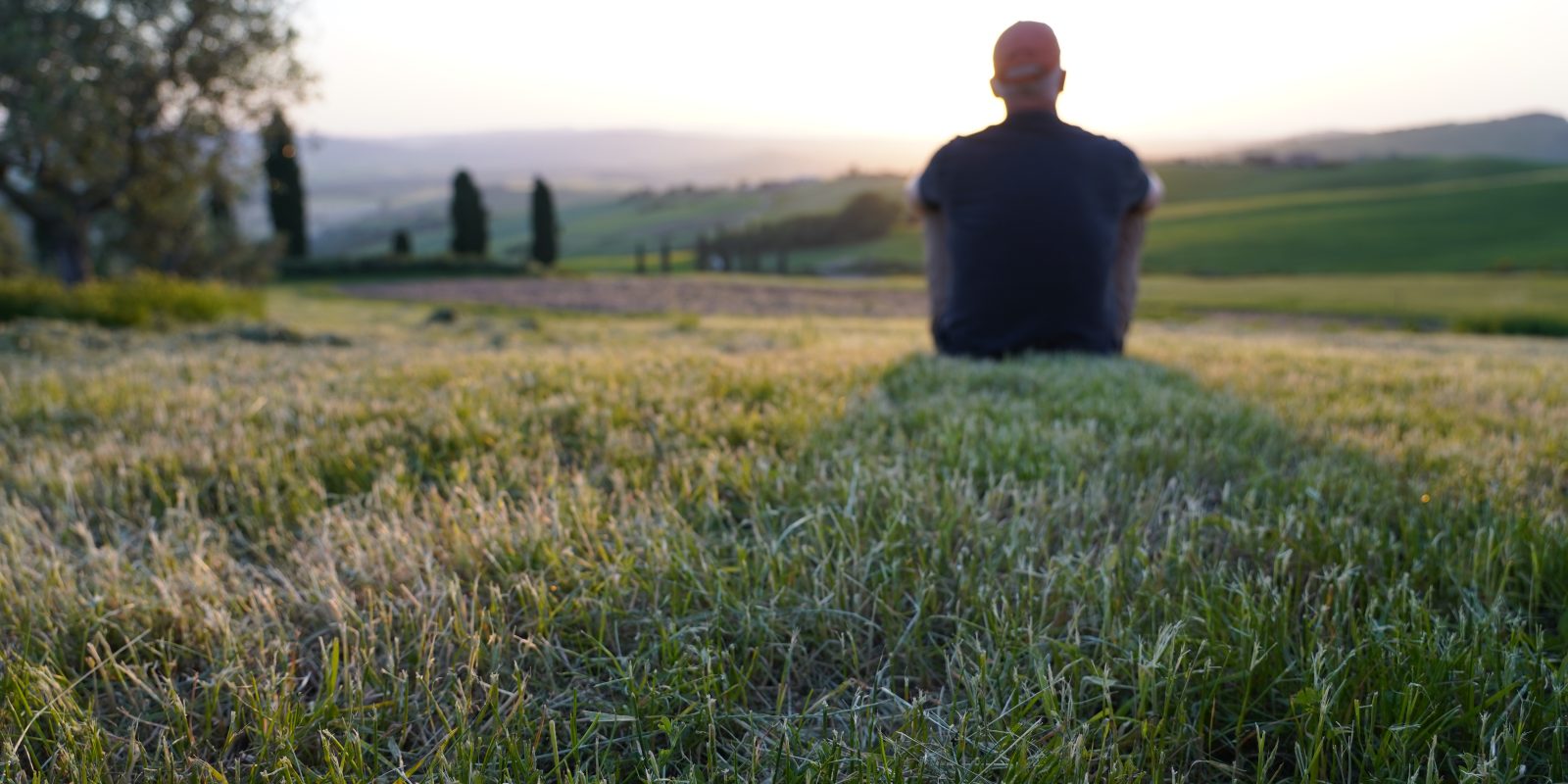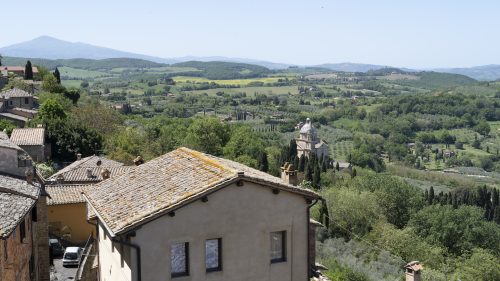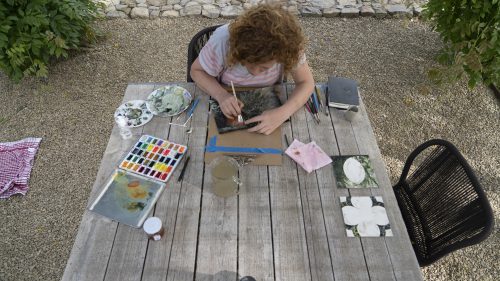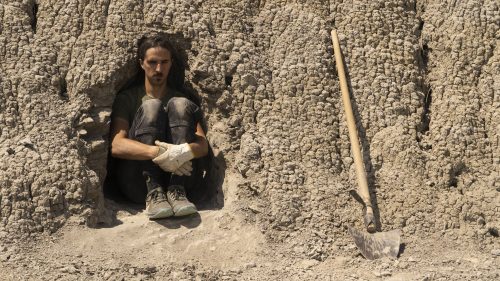
Leading an art residency for graduate students in Italy, art professor Cameron Schoepp finds inspiration for his own work in the Tuscan landscape. Courtesy of Adam Fung
Art Under the Tuscan Sun
A residency in Italy gives TCU graduate students a new perspective.
In Tuscany, artist Ben Loftis made use of the landscape, digging a nook into the side of a clay hill to house his body for a photographic work. Sarah Hunt created 75 small clay almonds and vessels to hold them, while Sheryl Anaya harvested plant matter to make dyes she used on fabric. Madi Ortega discovered inspiration in the hills she wandered, using chalk to draw a multicolored quilt atop a clay mound that she smoothed to serve as a natural canvas.
The TCU graduate students took part in a residency program in Italy in May 2022, offered to those entering the third year of their master’s in studio art program — the thesis year. Just the second group to experience this residency, the master’s candidates devoted their time to creating work, some of it site-specific, in an unstructured program led by Cameron Schoepp ’87 MFA, professor of art, and Adam Fung, associate professor of art. Both students and professors spent most of their time making art with materials largely found in nature during a 16-day stay in a century-old farmhouse.
Horned Frog Connections
The residency program started taking shape nearly five years ago thanks to Elliott Hill ’86, who serves on the university’s Board of Trustees.

La Foce overlooks the Val d’Orcia, a UNESCO World Heritage Site. Courtesy of Adam Fung
A recently retired Nike executive, Hill worked for the ubiquitous brand in Europe from 1998 to 2002, living in Amsterdam with his wife, Gina Hill, and their two children before returning to the United States to continue his career with the company.
Over the past two decades, the Hills made regular visits to southern Tuscany to see friends. Enchanted with life there, Elliott and Gina Hill — both of Italian descent and bearing Italian citizenship — eventually bought an old farmhouse on a 15th-century estate called La Foce, owned for centuries by the Origo family, with whom the Hills are now very close.
Animals, insects and birds resided in the farmhouse, which had cracked walls, missing windows and no electricity or plumbing — but boasted 360-degree views across the valley. The Hills hired local artisans and craftspeople to renovate the 1920s stone building and dubbed the home Cerreto, named for a nearby oak grove.
Offering Cerreto to TCU’s art program — along with funding to make the residency a reality — was a simple decision for the Hills.
“We collect and try to support artists with whom we have an emotional connection — to their work and to them as individuals. We decided we wanted to share our house with artists while honoring those who came from La Foce,” Elliott Hill said, referring to the Origo family, whose art-minded members have included a sculptor, a ballerina, authors and musicians. “We want to inspire students to continue chasing their dreams and following their passion.”

TCU MFA candidate Sarah Hunt works outdoors, using the Tuscan landscape as inspiration for her watercolor paintings. Courtesy of Adam Fung
As coordinator of TCU’s studio art graduate program, Schoepp made an exploratory trip to La Foce in 2018 with Richard Lane, director of TCU’s School of Art. After returning home, Schoepp worked with Fung to set parameters for the residency.
“We decided the grad students about to enter their third year made most sense; they’re at the right place to get an experience that mirrors residencies outside of academia,” Schoepp said. Fung added, “This sets them up for their thesis work by opening up pathways in their thinking.”
Schoepp believes putting the students in new settings imposes necessary fresh perspectives that a familiar home or school studio can’t, and being in a rural landscape lends itself to relaxed inspiration.
“They don’t make art in the house but are outside instead, which makes them think, ‘How do I make work in the wild?’ ” Fung said. “Cam and I both thought the open-air situation with no one around, unlike in the city, would be best.”
Art in Nature
The artists got to work as soon as they arrived at La Foce, overlooking the Val d’Orcia, about halfway between Rome and Florence. Some of the students had never been out of the United States, and one hadn’t flown before.
“It’s the most beautiful, extravagant place I’ve ever visited. And you’re so immersed in nature,” Anaya said. “You walk outside and look at the hills of Tuscany. So many wildflowers. Birds singing. One particular owl would hang outside our window all night.”

TCU MFA candidate Madi Ortega drew on a Tuscan clay mound with chalk. Courtesy of Adam Fung
Anaya said she appreciated working with materials within arm’s reach, such as the plants she used to make natural dyes. “The other graduate students and I also spent time pulling clay from the estate grounds. We dug a fire pit [for a kiln they crafted with Schoepp] to fire objects we made from the clay.”
In addition to the clay almonds and vessels she created, Hunt made watercolor and gouache paintings. Fung’s proficiency with drone cameras helped Hunt paint from night photos. “I took the night photography with different light sources that I inserted into the landscape and ultimately used a lot of that reference imagery to build a body of paintings,” Hunt said. She later exhibited the paintings in a small show at the Moncrief Cancer Institute in Fort Worth.
Ortega also worked in multiple mediums while abroad. “I found treasures on the ground, marking what or who had been there previously. I created watercolor paintings, drew on a clay mound and wasp nests with chalk, photographed insects from my walks, and made mud pies,” she said. “I drew and painted more than I’d ever been inspired to do before.”
Schoepp, a studio artist whose emphasis is sculpture, and Fung, a painter, delighted in creating work of their own. Days often involved hiking in the Tuscan hills, scavenging for items like wild porcupine quills they’d experiment with in making art back at the farmhouse.
Over dinner, they’d reflect on discoveries and find new directions. “Cooking meals for one another, sitting down and bouncing ideas for the week off each other, questioning possible routes through our thesis research, and offering close insight into our practices was important,” Hunt said. “These students have seen and critiqued my work across the last two years, and we trust one another.”
Schoepp and Fung took the students to an Etruscan museum near La Foce to see examples of early local art. Several of them gained insight by reading War in Val d’Orcia: An Italian War Diary, 1943-1944, a memoir by Iris Origo, who wrote in detail about La Foce and its surroundings.

TCU MFA candidate Ben Loftis dug out part of a clay hill for his
photography project. Courtesy of Adam Fung
Anaya visited a cathedral near Siena dedicated to St. Agatha, the subject of her forthcoming thesis exhibition; she also found paintings of St. Agatha when the group visited Florence.
After more than two weeks in Tuscany, the students traveled to Venice for the international art exhibition Biennale Arte. A significant event since 1895, the exhibition offered exposure to cutting-edge contemporary art, just as Florence museums provided classic examples.
“One pavilion invited viewers to enter one at a time into a silent experience through many rooms … where domestic, industrial and outdoor environments are empty except for you; the quiet makes you a little uncomfortable,” Ortega said. “According to Gian Maria Tosatti, the artist who created the installation, viewers are met with the relics of Italy’s industrial success with new understanding of the status of our climate.”
Continuing the Experience
After Venice, the students extended their Italian travels and research studies, thanks to grants secured beforehand. Back home again, they continued to reflect on their life-changing Italian experience.
“One thing I was reminded of was to not be afraid to take risks and to keep on making work. I remembered the importance of structure and routine as well as prioritizing my studio practice,” Anaya said.
“This trip gave me time to understand what is important to me and to my artwork. I have a greater understanding of who I am as a 24-year-old,” Ortega said. “Apart from having new ideas for my practice, I have learned who I want to be as an artist and what I want to put into the world.”
Elliott Hill said he could relate to the students’ personal evolution. “Attending TCU helped change how I view the world and broadened my perspective. To combine our love of art and our love of TCU with our love of La Foce and the Origo family to offer something bigger for all involved — it’s a real gift for us to be part of this experience.”

From left, Cameron Schoepp, Sheryl Anaya, Ben Loftis, Madi Ortega, Sarah Hunt and Adam Fung gather outside their temporary
home in the Tuscan hills. Courtesy of Adam Fung

Your comments are welcome
Comments
Related reading:
Features
Adam Fung’s Uncommon Arctic Adventure
The art professor is acting as an Arctic ambassador and filmmaker after his 19-day residency in the Far North.
Alumni
Artist Builds Flower Business
Alicia Price Rico ’04 pushes boundaries and finds fame through Bows and Arrows Flowers.